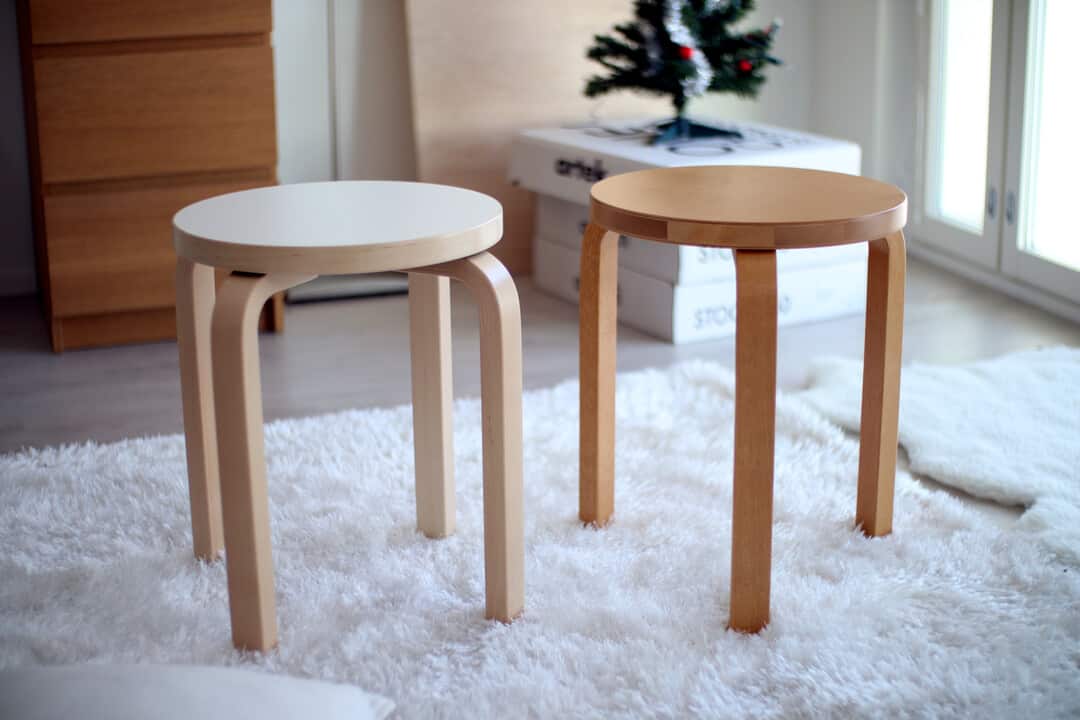For anyone who designs and builds furniture, it is worthwhile every now and then to take a look at a design classic. These products have often struck gold by an exceptional combination of form and function, and carry many lessons also for the DIY builder.
In this article, I am going to review one such product: the Stool 60 by the Finnish furniture manufacturer Artek, also known by its designer as Aalto Stool 60. We will start with a short introduction, move to my experience with the stool and a more detailed examination of the stool specs and versions. Finally, I will tell you where you can get the Stool 60 – also second-hand – and what you should note with the many replicas out there.
What is the Stool 60?
The Artek Stool 60 is a simple wooden three-legged round stool. Designed by the Finnish architect Alvar Aalto and introduced to the market in 1933, the stool has enjoyed almost a century of global popularity and become a design classic. The stool is currently produced and sold by the Finnish company Artek.
The Stool 60’s distinctive feature is L-shaped bent solid birch legs. The shape of these legs allows them to be screwed directly to the stool top, practically eliminating the need for aprons and stretchers.
The simple construction gives the stool a very minimal, modern and clean look perfect for Scandinavian or Minimalistic interior style. Thanks to the symmetry and flat top, the stool can also serve as a side table or a pedestral. When not needed, Stool 60’s can be stacked into a twisting tower.
The Artek Stool 60 is available in tens of color alternatives and also as a four-legged (E60) and children’s (NE60) versions. The key specifications of the stool are listed in the table below.
| Artek Stool 60/E60 Specifications: | |
|---|---|
| Seat height: | 17½” (44 cm) |
| Seat diameter: | 13½” (34.5 cm) |
| Seat material: | birch plywood+solid birch, birch |
| Weight: | 5.8…7.7 lb. (2.6…3.5 kg) |
| Price: | $250 … $500 (205€…405€) |
My impressions of Stool 60
Design: +++++
The design of the Stool 60 simple genius: this fully functional stool has only four components and three joints. Contrast this with a traditional wooden stool with aprons and stretchers, which totals 10…13 components and 13…17 joints, depending on the leg count and the details of the design.
The simple yet functional design of the Stool 60 is built on the L-shaped stool leg: the short part of the L mates with the stool top and serves as an attachment flange, giving plenty of area for a simple screw joint.
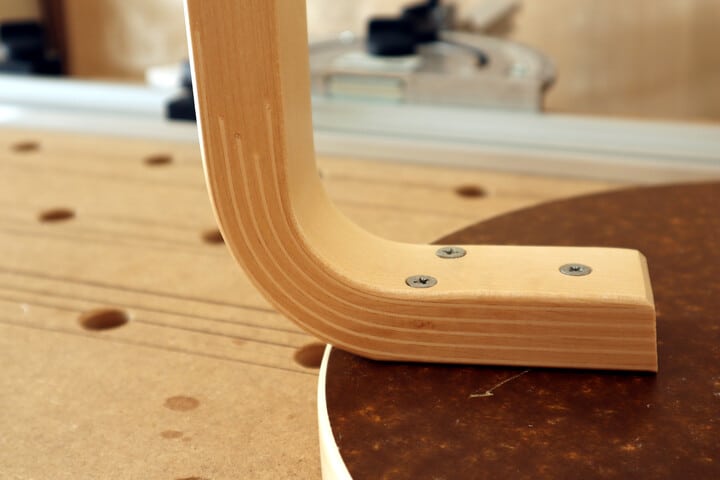
Despite having none of the typical supporting components for the legs, the Stool 60 is stable to sit on: I noticed no wobble or flex in normal use. The stool also appears quite tough and should be able to take heavier use, although I must admit I did not really dare to put its strength to the test.
The single weakness I have noticed in the stool design is that the screw connections have a tendency to loosen a bit with use, probably due to the racking forces the user puts on the stool. Considering the relatively short gripping length available in the stool top, I would have preferred to see threaded insert nuts and machine screws instead of the wood screws in these joints.
Ease of assembly: +++++
The Artek Stool 60 ships in a transport-friendly flat package and must be put together before use.
But unlike so many flat-pack pieces of furniture, the Stool 60 is actually very easy to assemble: just take the four components out of the package and join the legs to the top using the included 9 screws. The holes and pilot holes for these screws are ready, making positioning and screwing a breeze. This ease of assembly is an another testament to the clever design.
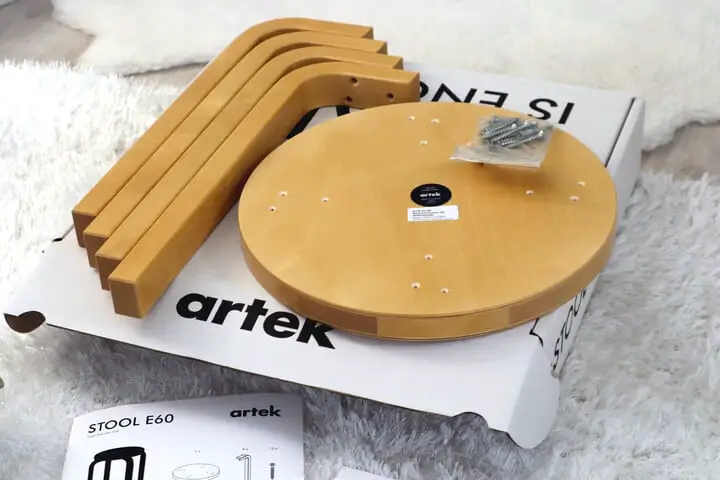
A cautionary note: beware of over-tightening the screws. The stool top is 1-1/8” thick and can offer only so much grip. Tighten by hand or with a low clutch setting. (I also recommend a second tightening after a month of use or so, as there seems to be some settling in the joint.)
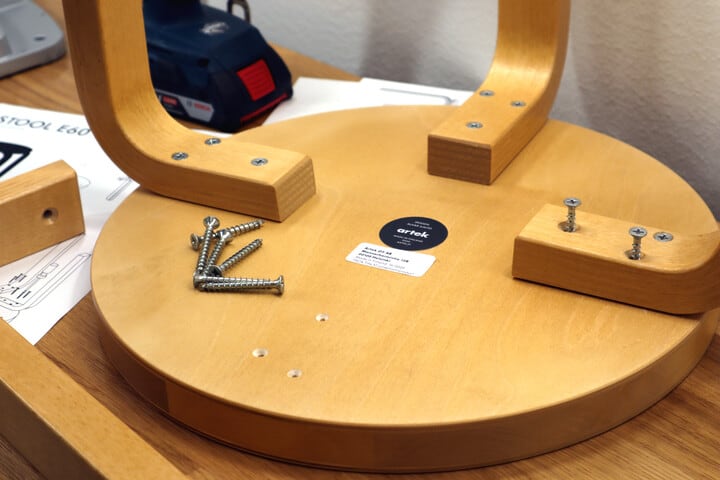
I give the ease of assembly 5/5 stars. The only small detail I would wish changing the cruciform drive to Torx, and perhaps replacing the wood screws with machine screws and nut inserts in the top.
Build quality: +++++
The Artek Stool 60 is made of durable birch, birch plywood and linoleum laminate, depending on the model. I found the production quality and finish very high on all of my three stools.
There are no apparent defects in the wood and the parts have been cut very clean. All edges have a consistent rounding or chamfer to them. The stain and lacquer are very even and the finished surfaces feel silky smooth to the hand.
The screwholes in the legs are pre-drilled and countersunk clean, and there are also pilot holes ready in the top. The included screws are Spax and not generic, which I really appreciate.
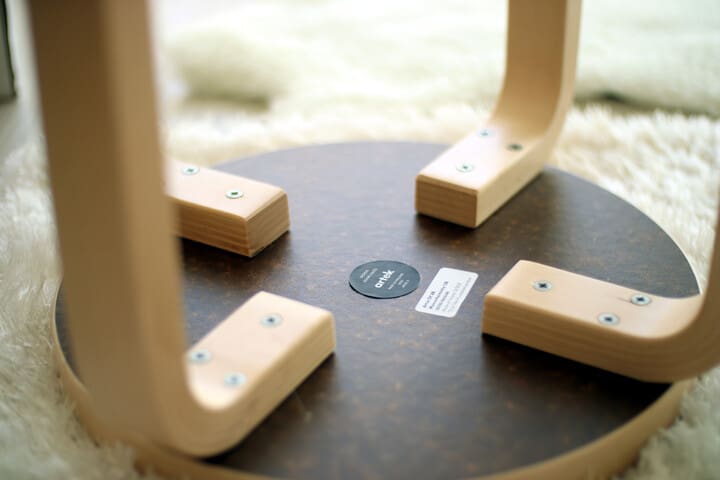
Overall, I judge the build quality to be excellent, and give it 5/5 stars. From a stool of this price, this is also what I would expect.
Overall: +++++
In the end, the merits of the Stool 60 should be weighed against its price tag. At between $250 and $500 (200€…400€) depending on the model, the Stool 60 is not particularly affordable – I guess you could even call it expensive. Admittedly, several hundred dollars or euros is a lot for a simple stool.
The Stool 60 is a functional, durable, compact and aesthetic piece of furniture, which should be able to stand the test of time both in terms of function and style.
In my mind, the Stool 60 also offers decent value even for the rather high price. The Stool 60 is a functional, durable, compact and aesthetic piece of furniture, which should be able to stand the test of time both in terms of function and style. It is also very flexible as it can double as a side table, and stacks away compact when not in use.
With the price taken into consideration, I give the Stool 60 an overall rating of 4/5 stars. You can find a summary of my assessment in the table below.
| Artek Stool 60/E60 Review summary: | Grade: |
|---|---|
| Design: | +++++ |
| Ease of assembly: | +++++ |
| Build quality: | +++++ |
| Overall: | +++++ |
What I liked: + durable + minimalistic + versatile + stacks compact | What I did not like: – expensive |
What made me buy
I hesitated for some time before buying the Stool 60 – after all, getting 3 to 4 of them at more than 200 euros a piece means putting quite some money into stools.
What pushed me over the edge was a combination of three things. First, the Stool 60 fits my current Scandinavian style and, being rather modest and unoffensive, is likely to many other interiors that I could consider.
Second, if they outlive their use as primary seats in my home, the stools can continue to serve as side tables or additional seats for guests, as they stack nicely into a tower and are therefore easy to store.
Third, were my Stool 60’s no longer needed for any purpose, their healthy aftermarket means that I do not have to throw them away. Instead I can actually sell them – even at a good price. This is a refreshing exception in the age of throwaway furniture.
Stool 60 versions
Colors
Artek Stool 60 is available in tens of different color combinations.
Base finishes: there are five base finishes which you can find on both the legs and the top:
- Birch: clear-lacquered natural birch. NB: the shade will darken with age
- Honey: warm light brown stain and clear lacquer on birch. I have found the actual shade to be a little lighter than what the product photos
- Walnut: a dark brown stain and clear lacquer on birch
- White: a pure white paint on birch
- Black: a black paint on birch
What I would note here is that I have found the wood shades somewhat lighter than as seen in most product photos. The clear “Birch” is a very light tan, almost white; the “Honey” is a light brown, similar to oak but warmer; the “Walnut” is a medium–dark brown.
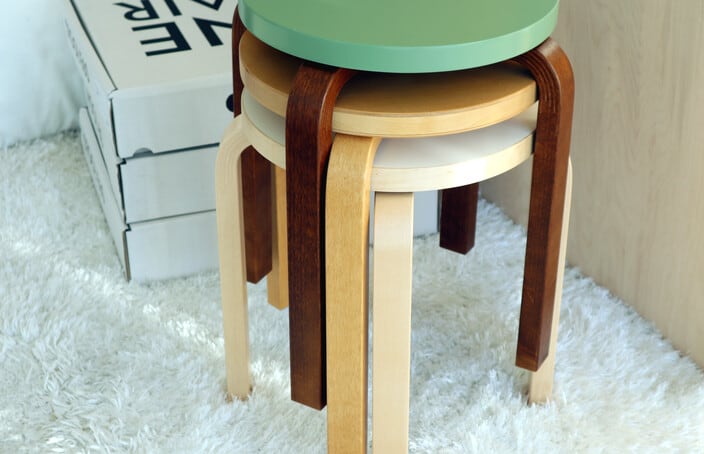
Top finishes: There is a much wider selection of finishes for the stool tops. In addition to the five base finishes, the tops come in around ten different paints and several linoleum laminate options. The paint/stain and laminate options actually come with a slightly different top construction (see image below).
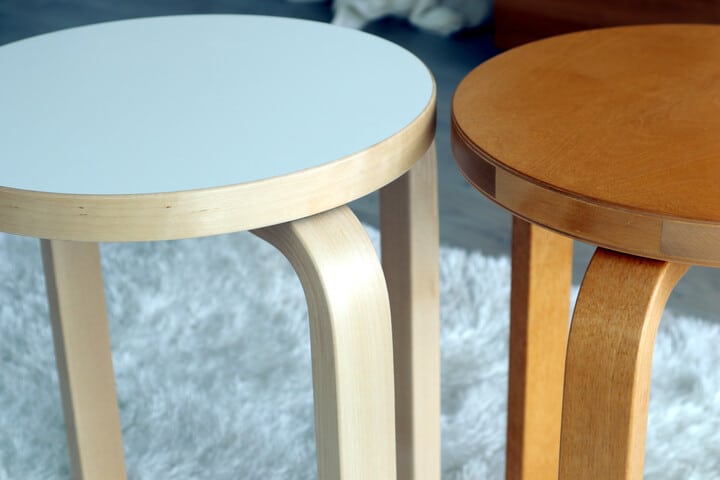
The available colors vary but common ones are grey, petrol, blue, light green, yellow, red, orange, red-orange (in addition to the base finishes). Note that the laminate tops have a wooden edge band with either a clear lacquer or walnut stain. Special upholstered and multi-color models such as the ‘ColoRing’ are also available occasionally.
Three-legged 60 vs. four-legged E60
The original Stool 60 has three legs, but there is also a follow-up model with four legs available – the Stool E60. The leg count is their only difference.
How do the Stool 60 and E60 compare?
The original three-legged Stool 60 is lighter, some tens of dollars/euros/pounds cheaper, and often available in more finishes. To me, it makes a stronger visual statement and underscores the modernist roots of the stool; this may be a pro or a con depending on your taste.
On the negative side, I have found the three-legged original Stool 60 less stable in use. To me, it also looks a bit unnatural and imbalanced when viewed from an angle where two of the legs line up, as shown in the image below.
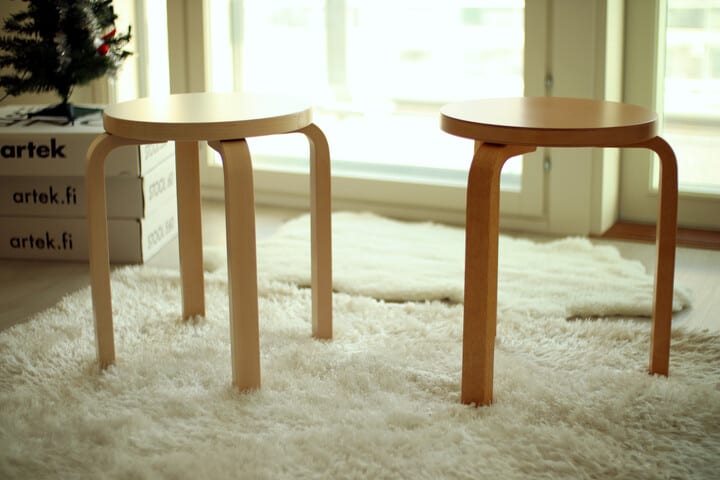
The four-legged Stool E60, on the other hand, is heavier and more expensive, but has some definite pros on its side. The E60 is not only more stable to sit on but also has a more harmonic, balanced look to it. Despite the price difference, the E60 is my favorite of the two.
Children’s Stool NE60
The Stool 60 is also available as a children’s version with shorter legs. The Children’s Stool NE60 has the same top as the 60 and E60, but a lower seat height of 38 cm or 15” (vs. 44 cm or 17½” in the originals). Based on my experience, the choice of four legs for better stability is here the right one.
Where to buy?
The Artek Stool 60 is sold globally by many online and brick-and-mortar furniture shops. Based on width of selection, I would highlight four retailers:
Finnish Design Shop: This online design retailer has probably the widest Stool 60 selection out there and ships to over 180 countries. Very competitive in Europe, US delivery is around $60 and takes a week.
Connox: A another online shop with a wide selection of Stool 60 models. Very competitive in Europe. US shipping also $50…$70 but free for orders above $890 (at least in Feb 2021).
Design Within Reach: A brick-and-mortar retailer with a wide US presence. The Stool 60 selection is not the widest but includes the most popular color versions. You may be able to see the stool in their stores.
Surrounding: An Australian mostly-online retailer with an impressive Stool 60 selection. A very competitive option if you shop from Australia.
Second hand
The Stool 60’s impressive value proposition is reflected in its high second-hand demand and prices.
Stools in ‘as new’ condition sell at almost the same price as new stock, and lightly worn with a discount of only around 10–20%. Refurbishers may find visibly worn stools and components also at substantially lower prices. At the opposite end of the spectrum, vintage Stool 60 models that are in decent condition often sell at a higher price than new ones.
While you can probably find pre-owned Stool 60’s at all online auction platforms, I would particularly recommend two:
Franckly.com: An online marketplace for pre-owned design, operated by Finnish Design Shop. Most Stool 60 versions are listed, but sell so fast that only a few are actually available at any given time. Sadly, ships to Europe only.
Ebay: Has many listings of Stool 60, particularly of vintage versions. I recommend to search for ‘Aalto stool’ or ‘Artek stool’ instead of ‘Stool 60’. International shipping.
Artek Stool 60 vs. Ikea Frosta
The success of the Stool 60 has inspired many other producers to come out with similar stool designs, most targeted to substantially lower price brackets.
A contemporary example is (or was) the Ikea Frosta. Priced at around 1/20th of the Artek stool, the Frosta is a lot, lot cheaper than the original, and could be passed for the same on a glance.
On a closer look, however, the Frosta stool differs significantly from the Artek one. To start, the Frosta stool top is thinner than the Artek top and made of a single piece of plywood instead of plywood-faced solid birch. Further, the Frosta legs are narrower and made of bent plywood, not solid birch.
What makes the a detailed comparison difficult is that the Frosta product photos on Ikea website actually display very different looking stools. Some have what looks like standard birch plywood in the legs and top; others have the top from a rougher looking plywood and legs that appear to be made of solid wood.
Although the Ikea Frosta seems to be discontinued in most regions as of 2021, other less famous Artek Stool 60 replicas are surely available. In my opinion, it is unlikely that these alternatives would offer a chair that is actually exactly the same as the Stool 60 at any substantially lower price.
